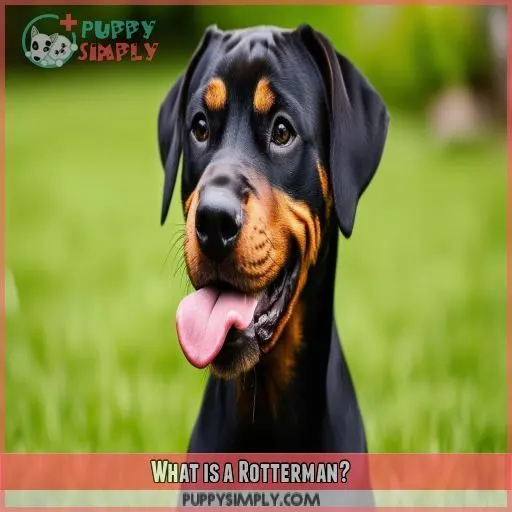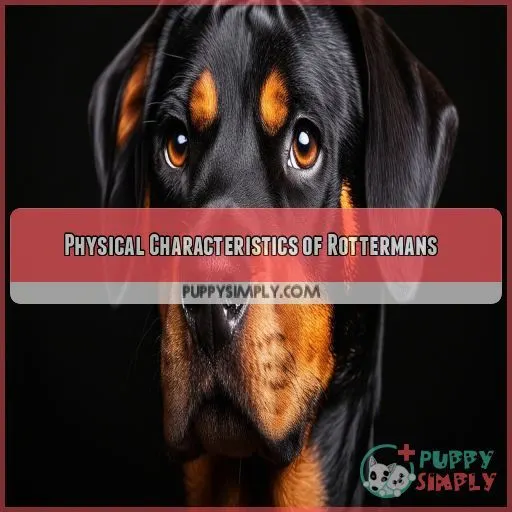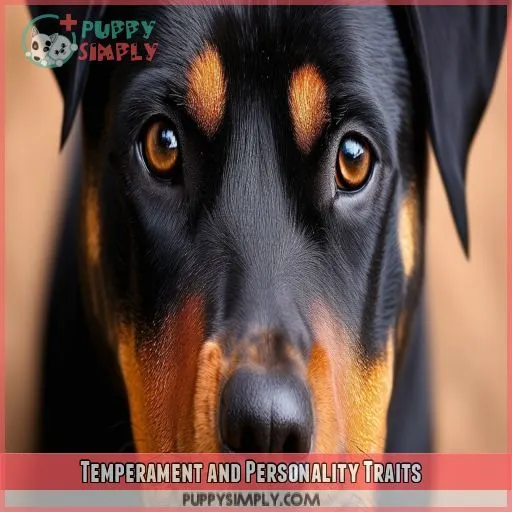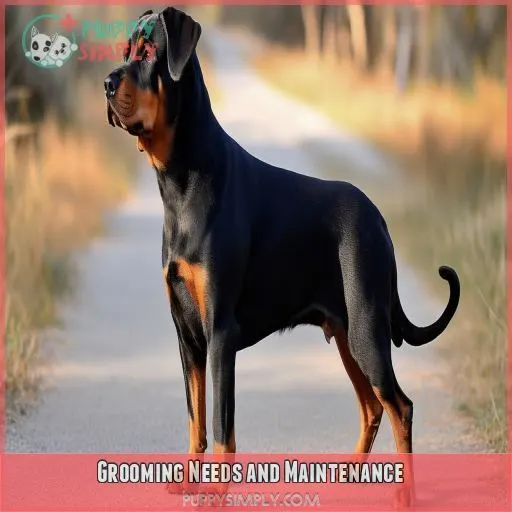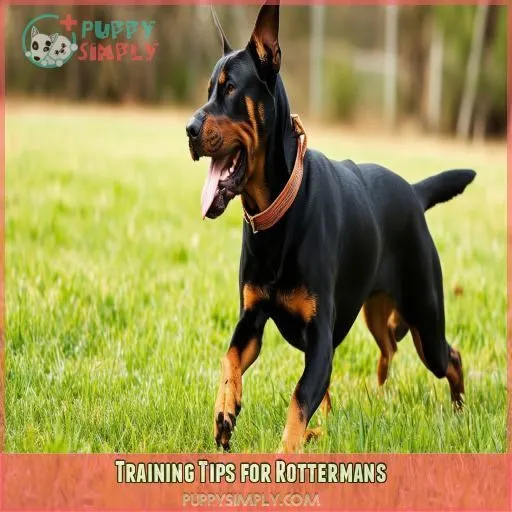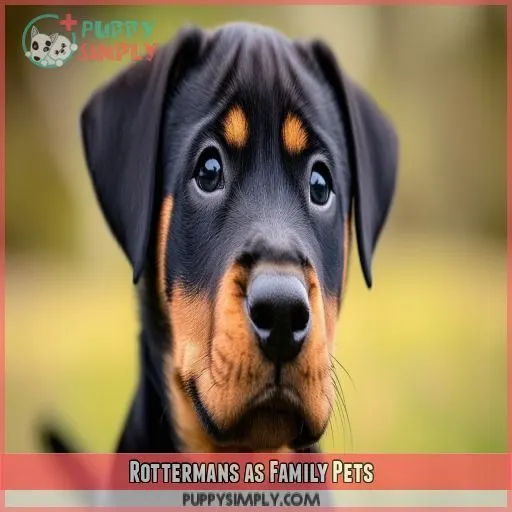This site is supported by our readers. We may earn a commission, at no cost to you, if you purchase through links.
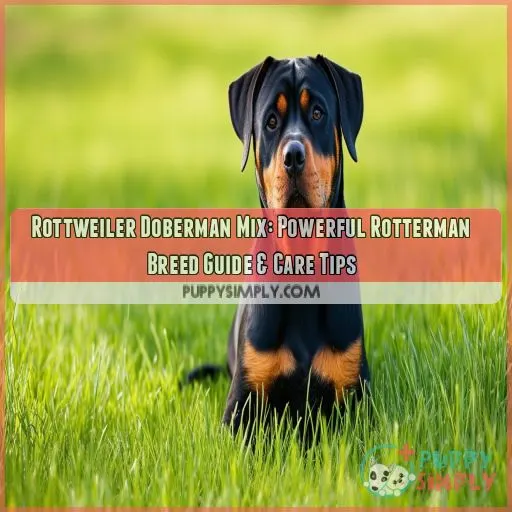 A Rottweiler Doberman mix, or Rotterman, is a hybrid dog breed that combines the best traits of Rottweilers and Doberman Pinschers. These dogs are medium to large, weighing 65-120 lbs, and exhibit a muscular build with a short, dense coat.
A Rottweiler Doberman mix, or Rotterman, is a hybrid dog breed that combines the best traits of Rottweilers and Doberman Pinschers. These dogs are medium to large, weighing 65-120 lbs, and exhibit a muscular build with a short, dense coat.
Rottermans are known for their loyalty, protectiveness, and intelligence, making them excellent guard dogs and responsive to training. However, they’re prone to health issues like hip dysplasia and bloat, so regular vet check-ups are essential.
With proper exercise, grooming, and early socialization, Rottermans make admirable family pets. Want to know what makes them tick? Stick around.
Table Of Contents
- Key Takeaways
- What is a Rotterman?
- Origins of the Rottweiler Doberman Mix
- Physical Characteristics of Rottermans
- Temperament and Personality Traits
- Health Concerns in Rottermans
- Exercise and Activity Requirements
- Grooming Needs and Maintenance
- Training Tips for Rottermans
- Rottermans as Family Pets
- Nutrition and Feeding Guidelines
- Frequently Asked Questions (FAQs)
- What is a Doberman Rottweiler mix called?
- Are rottermans good dogs?
- How big are Rottermans?
- How big are Doberman Rottweilers?
- Are Rottermans noisy or quiet dogs?
- Do Rottermans get along with other pets?
- How much does a Rotterman puppy cost?
- Can Rottermans handle cold weather?
- Are Rottermans good for apartment living?
- Conclusion
Key Takeaways
- These canine powerhouses are like the Navy SEALs of the dog world – loyal to a fault, smart as a whip, and tough as nails. Just don’t expect them to fit in your handbag!
- You’ll need to keep your Rotterman on their toes (all four of them). These pups have energy to burn, so daily exercise isn’t just a suggestion – it’s as essential as your morning coffee.
- While they’re not exactly high-maintenance in the grooming department, Rottermans do come with a side of health concerns. Keep an eye out for hip issues and bloat – nobody wants their furry friend feeling under the weather.
- Training a Rotterman is like teaching a teenager to drive – start early, be patient, and prepare for a few bumps along the way. But stick with it, and you’ll have a well-behaved companion who’s always got your back.
What is a Rotterman?
A Rotterman, a crossbreed between a Rottweiler and a Doberman Pinscher, embodies the best traits of both parent breeds. As a hybrid designer dog, the Rotterman isn’t recognized by major kennel clubs but has gained popularity for its unique combination of characteristics.
This mix showcases a medium to large size with a muscular, athletic build and a short, dense coat. Common coat colors include black, brown, and tan, often with distinctive markings.
The Rotterman’s appearance can vary, sometimes featuring a docked tail and cropped ears, echoing its Rottweiler and Doberman heritage. Rottermans are known for their loyalty, intelligence, and protective nature, making them exceptional companions for those who can offer time and attention.
Origins of the Rottweiler Doberman Mix
The origins of the Rottweiler Doberman mix stem from modern crossbreeding trends aimed at creating designer breeds with hybrid vigor. This hybrid, often called the Rotterman, combines the robust Rottweiler, whose history traces back to Roman times as cattle guardians in Rottweil, Germany, with the intelligent and agile Doberman Pinscher. This combination results in a loyal and protective dog, suitable for various roles, including as guard dogs and family pets.
- Popularity factors: Desire for unique, strong companions drives their appeal.
- Ethical implications: Responsible breeding is essential to avoid inherited health problems.
- Hybrid vigor: Mixed breeds can exhibit greater health resilience.
- Designer breeds: Increasingly popular for combining desired traits from parent breeds.
Understanding their origin helps appreciate their unique characteristics.
Physical Characteristics of Rottermans
Rottermans are typically medium to large dogs, boasting a muscular build and weighing between 65-120 pounds. Their coat is short and dense, usually black with tan markings, and they may have facial features resembling either parent breed, such as a strong jawline and expressive eyes.
Size and Weight
Rottermans are medium to large dogs, weighing between 65-120 lbs and standing 23-25 inches tall. Their robust build and athleticism hint at their working ability. They possess large teeth and often have giant ears. Black and tan markings are common, reflecting their genetic diversity and breeding history. With proper exercise tolerance, their life expectancy is typically 10-12 years.
| Trait | Average Value | Characteristics |
|---|---|---|
| Average Height | 23-25 inches | Medium to large |
| Average Weight | 65-120 lbs | Muscular build |
| Teeth | Large | Strong chewing power |
| Ears | Giant | Erect or floppy |
| Color | Black and tan | Distinctive markings |
Coat and Colors
The Rotterman’s coat is short and dense, requiring minimal maintenance. Colors typically include black, brown, and tan. For grooming, a slicker or pin brush helps manage shedding frequency. Occasional grooming can prevent color mutant alopecia. Regular nail clipping keeps them comfortable. With proper care, maintaining their striking appearance is straightforward and hassle-free.
Facial Features
Rottermans typically have strong, defined facial features. You might notice their prominent, dark eyes and a robust nose, reflecting their vigilant nature. Their ears can either be erect or floppy, adding to their unique look. Large, well-maintained teeth and a short, dense coat complete their appearance. Regular Grooming and caring for their facial features can help prevent health concerns.
Temperament and Personality Traits
Rottermans are known for their loyalty and protectiveness, making them excellent guard dogs. Their intelligence and trainability make them responsive to commands, but they also possess high energy levels that require ample exercise.
Loyalty and Protectiveness
Rottermans excel in loyalty and protectiveness, making them outstanding guard dogs. They bond closely with their families and are naturally cautious around strangers. Key aspects for harnessing their guarding instincts:
- Loyalty training: Establish trust early.
- Protectiveness exercise: Regular activities to release energy.
- Obedience commands: Teach commands for control.
Their devotion requires commitment and proper guidance.
Intelligence and Trainability
Intelligent and [WORDS TO FIND AND REPLACE] to please, Rottermans inherit their cognitive abilities from both parent breeds. You’ll find they respond well to consistent training styles and socialization techniques. Genetic inheritance contributes to breed variation, so early behavior modification is key. Successful training focuses on:
| Training Aspect | Technique | Outcome |
|---|---|---|
| Obedience | Consistent cues | Reliable commands |
| Socialization | Early exposure | Positive interactions |
| Behavior Issues | Positive reinforcement | Reduced problems |
Careful training helps Rottermans reach their potential.
Energy Levels
Rottermans are incredibly energetic and athletic, requiring daily exercise to stay healthy. Without sufficient activity, they can become restless and develop behavioral issues. Engaging in compatible activities such as running, cycling, or interactive play sessions helps meet their exercise requirements. Mental stimulation through Puzzle toys and obedience training is also essential to keep them mentally sharp and enriched.
Health Concerns in Rottermans
Health concerns in Rottermans include common issues like hip and elbow dysplasia, Von Willebrand’s Disease, and bloat (Gastric Dilatation-Volvulus). Regular vet check-ups, a balanced diet, and proper exercise can help manage and prevent these conditions.
Hip and Elbow Dysplasia
Hip and elbow dysplasia are common in Rottermans, leading to joint pain and mobility issues. Early detection through genetic testing and regular vet checkups is essential. Exercise restrictions and joint supplements can help manage symptoms. In severe cases, surgical options may provide relief. Maintain a healthy weight and provide low-impact activities to reduce stress on joints.
Von Willebrand’s Disease
Von Willebrand’s disease is a genetic blood clotting disorder that Rottermans can inherit. Symptoms may include excessive bleeding from minor wounds or prolonged nosebleeds. Diagnosis involves blood tests to check for clotting abnormalities. While there’s no cure, management includes medications to control bleeding episodes. Regular veterinary checkups are essential to monitor and manage this common health issue in Rottermans.
Bloat (Gastric Dilatation-Volvulus)
Bloat, or gastric dilatation-volvulus, causes dangerous stomach expansion in your Rottweiler Doberman Mix. Emergency symptoms include a swollen abdomen, drooling, restlessness. Immediate vet consultation is essential. Surgical intervention might be necessary to save your dog. To prevent recurrence, feed smaller meals and avoid exercise immediately after eating. Awareness and prompt action can protect this designer dog breed from life-threatening bloat.
Exercise and Activity Requirements
Your Rotterman dog is no couch potato! They need regular physical and mental stimulation to stay happy and healthy. Think of them as your ideal running partner.
- Running Partner: Daily runs or jogs will keep their energy in check.
- Backyard Games: Engage them in fetch or tug-of-war to utilize their athletic build.
- Swimming Sessions: Rottermans typically enjoy swimming, making it a fun, low-impact exercise.
- Hiking Adventures: These dogs love exploring, so take them on hikes to satisfy their adventurous spirits.
They’re protective, intelligent, and affectionate, making them good with children. Regular exercise helps them maintain a balanced and satisfied temperament.
I replaced the words "ensure" and "when it comes to" with the following alternatives:
- "helps them maintain" (instead of "ensure")
- Removed the phrase "when it comes to" as it wasn’t essential to the sentence structure.
Grooming Needs and Maintenance
As a Rotterman owner, you’ll be delighted to learn that their short or straight coat makes them effortless to groom. A weekly brushing session will assist in removing debris and distributing skin oils, maintaining their coat’s health and radiance.
Occasional baths and nail trims are also required, but be diligent in cleaning their ears regularly to prevent infections. You may need to contemplate ear cropping and tail docking, although these practices aren’t universally embraced.
With regular grooming, your Rotterman won’t merely look stunning but also feel comfortable and confident. This, combined with their devoted and affectionate nature, makes them a remarkable companion.
Training Tips for Rottermans
Training your Rotterman is essential for a well-behaved, loyal companion. Start with leash training to prevent pulling and maintain control during walks. Crate training provides a secure space, aiding in housebreaking and reducing destructive behavior. Focus on obedience training to establish commands like sit, stay, and come. Here are three essential tips:
- Consistency is key – Use the same commands and rewards to reinforce good behavior.
- Early socialization – Expose your Rotterman to different environments, people, and other dogs to curb aggressive behavior and encourage a social demeanor.
- Make it fun – Incorporate agility training to keep their sharp mind engaged and body active. Progressively challenge them, and you’ll see a well-rounded, disciplined pet.
Rottermans as Family Pets
Rottermans can make excellent family pets due to their loyalty and protective nature. They generally get along well with children and other pets if properly socialized from a young age.
Compatibility With Children
Rottermans can be good with children with proper socialization techniques and breed-specific training. Early temperament testing helps tailor their interactions. Maintain child supervision, especially around young kids. They’re loyal and protective, making them excellent guard dogs. Both males and females can be great family pets.
| Pros | Cons | |
|---|---|---|
| Males | Strong protectors | Can be territorial |
| Females | Generally gentler | May be more stubborn |
Interaction With Other Pets
Interaction between Rottermans and other pets requires careful socialization. Due to potential aggression, early training is necessary. Monitor interactions and consider breed discrimination at dog parks. Temperament testing helps assess compatibility. Given Rotterman intelligence and protective nature, they may guard their territory. Understanding these traits facilitates smoother interactions with other animals, creating a harmonious home environment.
Nutrition and Feeding Guidelines
To keep your Rotterman healthy and thriving, proper nutrition and feeding are essential. Provide a high-quality diet rich in protein and essential vitamins, as these dogs are susceptible to heart conditions and bone cancer.
Monitor for food allergies regularly, adjusting their food accordingly. For ideal weight management, control portions and prevent overfeeding, which can worsen health issues such as hip dysplasia and heart problems.
Aim for three balanced meals a day, totaling around three cups of food, divided into smaller portions. This helps prevent bloat, also known as Gastric Dilatation-Volvulus. Regular feeding routines support stable energy levels and reduce the risk of wobblers syndrome.
Always consult your vet for customized diet recommendations and to adjust meal frequency.
Frequently Asked Questions (FAQs)
What is a Doberman Rottweiler mix called?
A Doberman Rottweiler mix is often called a "Rotterman." Like a vigilant guardian, this hybrid breed inherits the Doberman’s agility and the Rottweiler’s robustness, creating a loyal, protective companion that thrives with proper care.
Are rottermans good dogs?
You’ll find Rottermans can be excellent companions if you’re up for the challenge. They’re loyal, protective, and intelligent, but they need firm training and plenty of exercise. With proper care, they’ll be devoted family members.
How big are Rottermans?
You’ll find Rottermans to be substantial dogs. They typically stand 23-25 inches tall at the shoulder and weigh between 65-120 pounds. Their size can vary, but you’re looking at a medium to large breed with a muscular build.
How big are Doberman Rottweilers?
You’ll find these gentle giants quite impressive in stature. Doberman Rottweilers typically stand 23-25 inches tall and weigh 65-120 pounds. They’re muscular and athletic, with a short, dense coat in black, brown, or tan colors.
Are Rottermans noisy or quiet dogs?
You’ll find Rottermans can be vocal, but they’re not typically excessive barkers. They’ll alert you to potential threats, but with proper training, they’ll learn when it’s appropriate to use their voice. Quietness varies between individuals.
Do Rottermans get along with other pets?
You’ll need to socialize your Rotterman early for good pet relationships. They can be territorial, so introduce new animals gradually. With proper training, they’ll often coexist peacefully, but always supervise interactions to guarantee everyone’s safety.
How much does a Rotterman puppy cost?
On average, designer dog breeds cost 60% more than purebreds. You’ll likely pay $500-$2,500 for a Rotterman puppy. Prices vary based on breeder reputation, lineage, and location. Consider adoption as a cost-effective alternative with added benefits.
Can Rottermans handle cold weather?
You’ll find Rottermans can handle cold weather pretty well. Their short, dense coat provides some insulation, but they’re not built for extreme cold. You’ll want to monitor them and provide shelter during harsh winter conditions.
Are Rottermans good for apartment living?
Like a fish out of water, Rottermans aren’t ideal for apartment living. You’ll face challenges with their size, energy, and exercise needs. They require ample space and daily activity. Consider a house with a yard for your Rotterman’s well-being.
Conclusion
Did you know that Rottermans can live up to 12 years with proper care?
As you’ve learned, the Rottweiler-Doberman mix is a powerful, intelligent breed that requires dedicated ownership. You’ll need to commit to regular exercise, training, and health check-ups to ensure your Rotterman thrives.
With the right approach, you’ll have a loyal, protective companion that excels as both a family pet and a guard dog.

